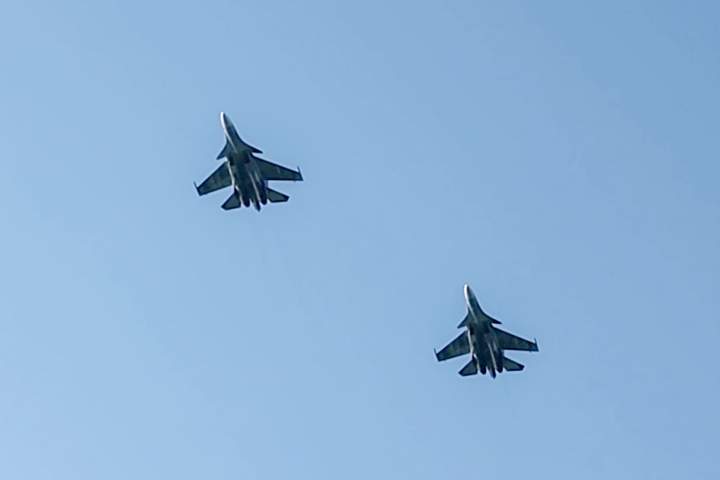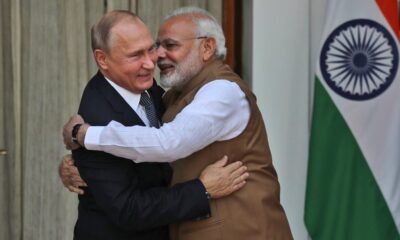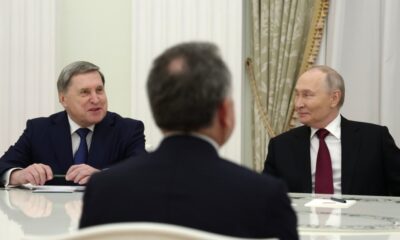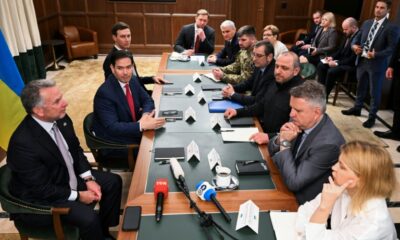World
Russian Jets Breach Estonia’s Airspace; NATO on High Alert

A significant incident occurred on Friday when Russian fighter jets entered Estonian airspace, prompting a swift response from NATO. According to a senior military official in Estonia, the violation lasted approximately 12 minutes and involved three Russian MiG-31 fighters that crossed into Estonian territory without authorization. This breach has raised concerns about the alliance’s capability to address airborne threats from Russia.
The Russian Defense Ministry countered these claims, asserting that its aircraft did not violate Estonia’s airspace. They stated that the jets were conducting a scheduled flight from Karelia to Kaliningrad and remained over neutral waters. However, Estonian officials firmly rejected this denial, citing radar and visual confirmation of the incursion.
Details of the Airspace Violation
The Russian jets entered Estonian airspace near Vaindloo Island in the Gulf of Finland between 09:58 and 10:10 local time. Col. Ants Kiviselg, commander of Estonia’s Military Intelligence Center, indicated that this was the fourth airspace violation by Russia within the year. He noted that although the Russian pilots did not pose an immediate military threat, they ignored communication attempts from Italian F-35 fighter jets that were part of NATO’s Baltic Air Policing Mission.
Kiviselg mentioned that while the Russian jets acknowledged the Italian pilots, they failed to respond appropriately. “Why they didn’t do it, that’s a question for the Russian pilots,” he stated. The Russian jets were tracked by Finnish aircraft prior to being escorted by the Italian jets, which took off from Estonia’s Ämari Air Base.
NATO’s Response and Regional Implications
Estonia’s Foreign Minister Margus Tsahkna characterized the incident as a serious violation of NATO airspace. He drew parallels with a similar situation in 2003, prior to Estonia’s NATO membership, highlighting the gravity of the current breach. In light of the incident, Estonia’s government announced plans to request consultations under Article 4 of NATO’s treaty, a provision that allows member states to discuss threats to their territorial integrity with allies.
Additionally, the situation follows a recent breach involving approximately 20 Russian drones that entered Polish airspace on September 10, 2023. This pattern of incursions has led some officials, including Czech President Petr Pavel, to call for a robust response from NATO. Pavel emphasized the need for the alliance to consider all options, including the potential interception of Russian aircraft.
Despite the tensions, Estonian officials have stated that there is currently no need to invoke Article 5 of NATO’s collective defense clause, which commits member states to defend each other in the event of an attack. They assert that the repeated violations do not necessarily indicate an escalation to direct conflict.
Estonia’s Defense Minister Hanno Pevkur expressed confidence in the capability of NATO and its allies to monitor the situation. He noted that the Estonian military and its partners were closely observing the Russian jets’ movements, communications, and armaments, concluding that there was no immediate risk necessitating defensive action.
In a statement, Pevkur criticized the Russian Defense Ministry’s claims of remaining in neutral waters, asserting that there is substantial evidence confirming the violation. He suggested that these incursions could be part of a broader strategy to divert Western attention from the ongoing conflict in Ukraine.
The situation in the Baltic region remains tense, as NATO members continue to address the implications of Russian military actions. The alliance’s response to these provocations will likely shape the security framework in Eastern Europe for the foreseeable future.
-

 Politics4 weeks ago
Politics4 weeks agoSecwepemc First Nation Seeks Aboriginal Title Over Kamloops Area
-

 World5 months ago
World5 months agoScientists Unearth Ancient Antarctic Ice to Unlock Climate Secrets
-

 Entertainment5 months ago
Entertainment5 months agoTrump and McCormick to Announce $70 Billion Energy Investments
-

 Science5 months ago
Science5 months agoFour Astronauts Return to Earth After International Space Station Mission
-

 Lifestyle5 months ago
Lifestyle5 months agoTransLink Launches Food Truck Program to Boost Revenue in Vancouver
-

 Technology3 months ago
Technology3 months agoApple Notes Enhances Functionality with Markdown Support in macOS 26
-

 Lifestyle3 months ago
Lifestyle3 months agoManitoba’s Burger Champion Shines Again Amid Dining Innovations
-

 Top Stories2 months ago
Top Stories2 months agoUrgent Update: Fatal Crash on Highway 99 Claims Life of Pitt Meadows Man
-

 Politics4 months ago
Politics4 months agoUkrainian Tennis Star Elina Svitolina Faces Death Threats Online
-

 Sports5 months ago
Sports5 months agoSearch Underway for Missing Hunter Amid Hokkaido Bear Emergency
-

 Politics5 months ago
Politics5 months agoCarney Engages First Nations Leaders at Development Law Summit
-

 Technology5 months ago
Technology5 months agoFrosthaven Launches Early Access on July 31, 2025




















